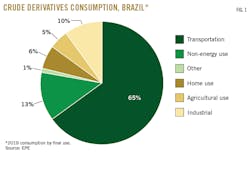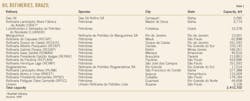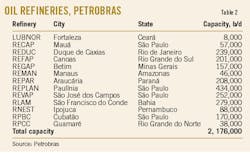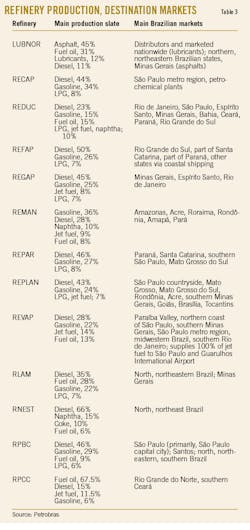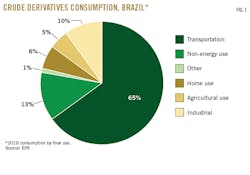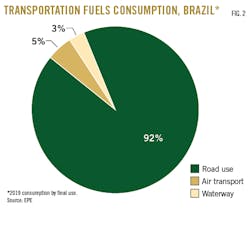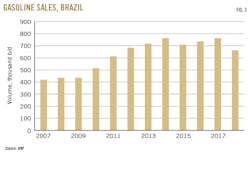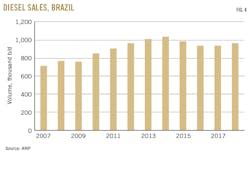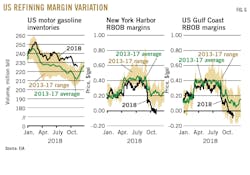Brazil’s downstream divestment program offers opportunities, risks
Marcio Wagner da Silva
Consultant
São José dos Campos, São Paulo, Brazil
The government of Brazil is progressing with a program to open the national refining sector to private capital investments by selling about half of partially state-owned Petróleo Brasileiro SA’s (Petrobras) installed crude processing capacity as part of the company’s broader 2020-24 strategic plan to increase competitiveness, efficiency, and profitability across its operations (OGJ Online, May 2, 2019).
While projections from Brazil’s Agência Nacional do Petróleo, Gás Natural e Biocombustíveis (ANP), and Empresa de Pesquisa Energética (EPE) indicate steady growth in the country’s demand for transportation fuels and petroleum derivatives offer attractive incentives for potential investors, uncertainties regarding the federal government’s future involvement in pricing of crude oil derivatives, as well as its post-sale integration plan for related sectors, could limit the scale of private investment.
This article provides an overview and update on the current status of Brazil’s downstream divestment program, as well as outlining associated opportunities and possible roadblocks involved for fiscal partners entering the sector.
Brazil’s refining industry
Given Brazil’s substantial dependence on road transportation to meet its logistical needs, all Brazilian refineries are optimized to maximize production of transportation fuels, especially middle distillates like diesel and jet fuel.
ANP data released in March 2020 showed that—in addition to three major petrochemical complexes, 51 biodiesel production units, and 360 ethanol plants—Brazil’s downstream sector includes a mix of 18 privately and state-owned refineries with a combined crude processing capacity of just over 2.41 million b/d (Table 1).
Excluding the Refinaria Landulpho Alves Fábrica de Asfalto (FASF) asphalt plant and its Unidade de Industrialização do Xisto (SIX) industrial shale processing plant in São Mateus do Sul, Paraná, Petrobras—which is owned by the Brazilian federal government 50.26% and various public-sector entities 49.66%—operates 13 of these refineries with a total nameplate crude processing capacity of more than 2.37 million b/d, accounting for about 99% of the country’s overall installed capacity, according to ANP.
In its latest annual report to investors released Mar. 23, 2020, however, Petrobras adjusted operational crude distillation capacity for its 13 major refineries as of yearend 2019 to 2.176 million b/d, which still represents 99% of total Brazilian refining capacity (Table 2).
Located near crude oil pipelines, storage terminals, refined-product pipelines, and petrochemical plants, Petrobras’s refineries process a mix of mostly domestically produced crude oil (more than 90%) and imported grades to produce about 1.8 million b/d of products—including diesel, gasoline, low-sulfur fuel oil, naphtha, LPG, and jet fuel—for distribution and sale predominantly to domestic buyers, but also for export abroad. In 2019, Petrobras sold 90% of its 1.779 million-b/d of refined products output to the Brazilian market.
Table 3 shows the main products and destination markets for Petrobras’s refineries.
Downstream divestment program
First announced in April 2019, Petrobras’s downstream divestment program involves the sale of seven of Petrobras’s Brazilian refineries with total processing capacity of 1.1 million b/d, or roughly 50% of Brazil’s installed refining capacity. Petrobras additionally has committed to sell its SIX shale industrialization unit as part of the plan.
Official opportunity disclosures issued by Petrobras inviting interested investors to take part in the bidding process describe the processing sites, capacities, and associated assets included in the divestment program as follows:
- REMAN; 46,000 b/d; storage terminal.
- LUBNOR; 8,000 b/d.
- RNEST; 130,000 b/d; storage terminal and 101 km of short pipelines.
- RLAM; 333,000 b/d; four storage terminals and pipelines totaling 600 km.
- REPAR; 208,000 b/d; five storage terminals and 476 km of pipelines.
- REFAP; 208,000 b/d; two storage terminals and pipelines totaling 260 km.
- REGAP; 166,000 b/d; more than 720 km of pipelines.
- SIX; 6,000 b/d; a mine in one of the largest oil shale reserves in the world and a shale processing plant.
In June 2019, Petrobras entered an agreement with Brazil’s Administrative Council for Economic Defense (CADE) consolidating an understanding between the parties governing the operator’s proposed divestments of refining assets (OGJ Online, June 12, 2019). The agreement provided competitive conditions encouraging new economic agents to enter the downstream market, as well as suspending an earlier administrative inquiry opened by the CADE Court to investigate alleged abuse of Petrobras’s dominant position in the refining segment.
Alongside providing a series of scheduling, methodology, and financial compliance requirements for the proposed sales, the agreement also stipulated that the following refineries considered as potential competitors may not be acquired by the same buyer or companies within the same economic group:
- RLAM, RNEST.
- REPAR, REFAP.
- REGAP, RLAM.
To ensure integrity of the divestment plan, Petrobras also agreed that the schedule and fulfillment of the commitments assumed with CADE will be followed up on by an external agent hired by Petrobras according to specifications to be established by mutual agreement.
While Petrobras initiated binding phases in late 2019 and early 2020 for the sale of its seven refineries, the SIX plant, and associated logistics assets, the company recently postponed receipt of binding offers into the downstream divestment program to allow potential buyers enough time to conduct thorough due diligence amid delays to normal business operations due to the coronavirus outbreak (OGJ Online, Mar. 20, 2020). A timeframe for when the sale process will resume has yet to be determined.
Opportunities
As the world’s seventh largest consumer of crude oil derivatives and its third largest consumer of transportation fuels specifically, Brazil offers potential downstream investors the stability of a domestic market on which demand for finished products—particularly diesel and jet fuel—is projected to steadily increase. Data from the EPE shows Brazilian market demand for crude derivates will grow 2.5%/year through 2026, with ANP data showing domestic demand for derivatives during the same period rising 20% from its current demand of 2.4 million b/d. While production from Petrobras’s refineries meets the bulk of Brazil’s present demand, the country still requires about 500,000 b/d of derivative imports to fully satisfy domestic needs.
Fig. 1 shows the distribution of crude oil derivatives consumption in the Brazilian market by final use during 2019.
Because most of Brazil’s cargo and passenger transport occurs via roadways, automotive fuels represent 92% of crude derivatives consumed by the country’s transportation sector (Fig. 2).
Despite dipping in the wake of a severe economic recession that hit the country beginning in late 2014, Brazil’s demand for and consumption of gasoline and diesel fuels since 2007 has generally trended upward alongside modest but steady development of the nation’s economy (Figs. 3-4). During the last 3 years, the Brazilian economy has been slowly growing, rising 1.2% in 2019 amid recovery of the construction sector and growth of the service sector, according to the Brazilian Institute of Geography and Statistics (IBGE).
While substitution for gasoline by cheaper hydrous ethanol and increased use of flex-fuel automobiles has weighed on Brazil’s demand, the country’s overall demand for oil products—especially diesel, its most-consumed derivative—in 2019 rose by 1% from 2018. As domestic industry sectors continue to recover and Brazil’s population continues to grow, demand for petroleum derivates will follow, offering outside economic partners secure returns on investment.
EPE and ANP projections for continued growth in demand for oil derivates may position the Brazilian market as even more relevant for external partners in view of current reduced demand for transportation fuels in more economically developed markets, which have led refiners in those regions to focus their operations on production of petrochemical intermediaries. Markets such as Brazil and India—both of which have strong demand for transportation fuels—can become the destination for surplus products resulting from reduced consumption in these more developed markets.
Risks
Despite the intention of the government to attract private investment to the Brazilian refining sector in an effort to increase competitiveness and thereby reduce pricing of derivatives, one of the main barriers regarding opening the market to outside investors is ongoing state interference in the country’s fuel market.
After the end of the government monopoly on crude oil exploration, refining, and commercialization in 1997, the government’s pricing policy for oil derivatives prevented Brazil’s refining sector from experiencing any substantial private investment.1
While Brazil is the world’s fifth largest country with a population of about 208 million and hosts its eighth largest economy, logistical infrastructural constraints leave the nation highly dependent on road. This has left the Brazilian economy extremely sensitive to the price of crude derivatives, especially diesel, according to data from ANP and the Relatório de Inflação of Brazil’s Instituto de Pesquisa e Estratégia Econômica do Ceará (IPECE).
Fig. 5 shows the direct relationship between the rise in gasoline and diesel pricing and corresponding inflation observed 2013-19.
After 2015, inflation fell despite the continuous rise in fuel prices, abated by Brazil’s severe recession, which produced high unemployment taxes and eroded the domestic consumption.
Crude oil derivatives, however—which are responsible for nearly 5.6% in the composition of Brazil’s inflation calculation index—are still part of product sets that have prices controlled by the Brazilian federal government. Over the years, this has allowed the government to interfere with prices in an attempt to minimize inflation. This tendency to intervene in the market, independent of the ideology acting in the power, greatly impacts the population’s quality of life as well as carrying a deep political cost. The price interference also creates an insecure environment for outside agents considering investing in the Brazilian downstream sector.
Investment in any refining enterprise requires potential investors to ensure a rate of profitable return on their investments, typically measured by refining margins. These returns are typically smaller than the rate of return on upstream investments. For example, data from the US Energy Information Administration (EIA) showed that during 2013-18, as industry focused on rapidly expanding production of unconventional, domestic shale reserves, refining margins suffered as US refiners struggled to raise capital to equip existing manufacturing sites—predominantly outfitted to run heavier, sour grades—with the ability to process lighter, sweeter crudes sourced from shale production (Fig. 6).
Reduced refining margins and the high capital investment costs required to optimize Brazil’s processing operations, particularly when coupled with government price management, threaten to drive away investment in the nation’s refining sector. Another point that does not seem clear and may bring additional risks for potential investors under the federal government’s defined sales strategy is its silence regarding any definitive plan for integration of the downstream and midstream sectors following sale of the refining assets, most of which depend on—and are located in proximity to—existing midstream assets owned and operated by Petrobras for delivery to end users.
Despite the many attractive characteristics of Brazil’s downstream for outside investors, there does not seem to be any certainty that Brazil’s derivative pricing will be free of government interference and at parity to international market pricing after conclusion of the downstream divestment process, triggering what could be a new wave of investor aversion to the Brazilian refining sector.
Reference
- De Almeida, E.L.F, Oiveira, P.V., Losekann, L., “Impactos da contenção dos preços de combustíveis no Brasil e opções de mecanismos de precificação,” Brazilian Journal of Political Economy, Vol. 30, No. 3 (140), July-Sept. 2015, pp. 531-556.
The author
Marcio Wagner da Silva ([email protected]) is a process engineer and project manager focusing on crude oil refining, with extensive experience in research, design, and construction, as well as developing and coordinating projects for operational improvements and debottlenecking bottom-of-the-barrel units. Based in São José dos Campos, São Paulo, Brazil, da Silva holds a BS (2004) in chemical engineering from Universidade Estadual de Maringá, Paraná, an MBA (2006) in project management from Universidade Federal do Rio de Janeiro, and a PhD (2010) in chemical engineering from Universidade Estadual de Campinas, São Paulo. He is certified in business and finance by Fundação Getulio Vargas.
